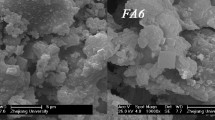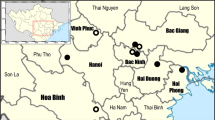Abstract
The focus of the current study is to characterise the leaching behaviour of polycyclic aromatic hydrocarbons (PAHs) from oil shale ashes (OSAs) of pulverised firing (PF) and circulating fluidised-bed (CFB) boilers from Estonian Thermal Power Plant (Estonia) as well as from mortars and concrete based on OSAs. The target substances were 16 PAHs from the EPA priority pollutant list. OSA samples and OSA-based mortars were tested for leaching, according to European standard EN 12457-2 (2002). European standard CEN/TC 15862(2012) for monolithic matter was used for OSA-based concrete. Water extracts were analysed by GC–MS for the concentration of PAHs. Naphthalene, acenaphthene, fluorene, phenanthrene, anthracene, fluoranthene and pyrene were detected. Still, the release of PAHs was below the threshold limit value for inert waste. The amount of the finest fraction (particle size <0.045 mm), the content of the Al–Si glass phase and the surface characteristics were the main factors, which could affect the accessibility of PAHs for leaching. The mobility of PAHs from OSA of CFB and PF boilers was 20.2 and 9.9 %, respectively. Hardening of OSA-based materials did not lead to the immobilisation of soluble PAHs. Release of PAHs from the monolith samples did not exceed 0.5 μg/m2. In terms of leaching of PAHs, OSA is safe to be used for construction purposes.






Similar content being viewed by others
References
Barbosa R, Lapa N, Lopes H, Gulyurtlu I, Mendes B (2011) Stabilization/solidification of fly ashes and concrete production from bottom and circulating ashes produced in a power plant working under mono and co-combustion conditions. Waste Manag 31(9–10):2009–2019
Blinova I, Bityukova L, Kasemets K, Ivask A, Käkinen A, Kurvet I, Bondarenko O, Kanarbik L, Sihtmäe M, Aruoja V, Schvede H, Kahru A (2012) Environmental hazard of oil shale combustion fly ash. J Hazard Mater 229–230:192–200
Blissett RS, Rowson NA (2012) A review of the multi-component utilisation of coal fly ash. Fuel 97:1–23
Butera S, Christensen TH, Astrup TF (2014) Composition and leaching of construction and demolition waste: inorganic elements and organic compounds. J Hazard Mater 276:302–311
Cinquepalmi MA, Mangialardi T, Panei L, Paolini AE, Piga L (2008) Reuse of cement-solidified municipal incinerator fly ash in cement mortars: physicomechanical and leaching characteristics. J Hazard Mater 151(2–3):585–593
Dalgren KE, Düker A, Arwidsson Z, von Kronhelm T, van Hees PAW (2011) Recycling of remediated soil—evaluation of leaching tests as tools for characterization. Waste Manag 31(2):215–224
Directive 2013/39/EU (2013) of the European parliament and of the Council of 12 August 2013 amending Directives 2000/60/EC and 2008/105/EC as regards priority substances in the field of water policy. Off J Eur Union L 226:1–17
Enell A, Fuhrman F, Lundin L, Warfvinge P, Theilin G (2008) Polycyclic aromatic hydrocarbons in ash: determination of total and leachable concentrations. Environ Pollut 152(2):285–292
European standard CEN/TC 15862 (2012) Characterization of waste—compliance leaching test—one stage batch leaching test for monoliths at fixed liquid to surface area ratio (L/A) for test portions with fixed minimum dimensions. European Committee for Standardization Brussels 2012
European standard EN 12457-2 (2002) Characterization of waste–Leaching–Compliance test for leaching of granular waste materials and sludges—part 2. European Committee for Standardization Brussels 2003
Garrabrants AC, Kosson DS, DeLapp R, van der Sloot HA (2014) Effect of coal combustion fly ash use in concrete on the mass-transport release of constituents of potential concern. Chemosphere 103:131–139
Harvey RG (1997) Polycyclic aromatic hydrocarbons. Wiley-VCH, New York
Harvey RG (1998) Environmental chemistry of PAHs. In: Neilson AH (ed) The handbook of environmental chemistry: PAHs and related compounds. Springer, New York, pp 1–54
IARC (2010) Monographs on the evaluation of carcinogenic risks to humans. Volume 92 some non-heterocyclic polycyclic aromatic hydrocarbons and some related exposures. Lyon, France
Irha N, Uibu M, Jefimova J, Raado LM, Hain T, Kuusik R (2014) Leaching behavior of Estonian oil shale ash-based construction mortars. Oil Shale 31(4):394–411
Jefimova J, Irha N, Reinik J, Kirso U, Steinnes E (2014) Leaching of polycyclic aromatic hydrocarbons from oil shale processing waste deposit: a long-term field study. Sci Total Environ 481:605–610
Kanarbik L, Blinova I, Sihtmäe M, Künnis-Beres K, Kahru A (2014) Environmental effects of soil contamination by shale fuel oils. Environ Sci Pollut Res 21:11320–11330
Karamalidis AK, Voudrias EA (2007) Cement-based stabilization/solidification of oil refinery sludge: leaching behavior of alkanes and PAHs. J Hazard Mater 148:122–135
Kirso U, Laja M, Urb G (2005) Polycyclic aromatic hydrocarbons (PAH) in ash fractions of oil shale combustion: fluidized bed versus pulverized firing. Oil Shale 22(4):537–545
Kirso U, Irha N, Reinik J, Urb G, Laja M (2007) The role of laboratory and field leaching tests in hazard identification for solid materials. ATLA 35(1):119–122
Krüger O, Kalbe U, Berger W, Simon FG, Meza SL (2012) Leaching experiments on the release of heavy metals and PAH from soil and waste materials. J Hazard Mater 207–208:51–55
Kuusik R, Uibu M, Kirsimäe K (2005) Characterization of oil shale ashes formed at industrial-scale CFBC boilers. Oil Shale 22(4):407–419
Kuusik R, Uibu M, Kirsimäe K, Mõtlep R, Meriste T (2012) Open-air deposition of Estonian oil shale ash: formation, state of art, problems and prospects for the abatement of environmental impact. Oil Shale 29(4):376–403
Laja M, Urb G, Irha N, Reinik J, Kirso U (2005) Leaching behavior of ash fractions from oil shale combustion by fluidized bed and pulverized firing processes. Oil Shale 22(3):453–465
Leoni M, Scardi P, Pelosato R, Sora IN, Dotelli G, Stampino PG, Presti AL (2007) Phase composition gradient in leached polluted cement monoliths. Cem Concr Res 37:1483–1495
Li H, Liu G, Cao Y (2014) Content and distribution of trace elements and polycyclic aromatic hydrocarbons in fly ash from a coal-fired CHP plant. Aerosol Air Qual Res 14:1179–1188
Liu K, Xie W, Zhao ZB, Pan WP, Riley JT (2000) Investigation of polycyclic aromatic hydrocarbons in fly ash from fluidized-bed combustion systems. Environ Sci Technol 34:2273–2279
Liu Y, Li Y, Li X, Jiang Y (2008) Leaching behavior of heavy metals and PAHs from MSWI bottom ash in a long-term static immersing experiment. Waste Manag 28:1126–1136
Lupsea M, Tiruta-Barna L, Schiopu N (2014) Leaching of hazardous substances from a composite construction product—an experimental and modelling approach for fibre-cement sheets. J Hazard Mater 264:236–245
Mackay D, Callcott D (1998) Partitioning and physical chemical properties of PAHs. In: Neilson A (ed) PAHs and related compounds, Chemistry. Springer-Verlag, Berlin, pp 325–346
Mackay D, Shiu WY, Ma KC, Lee SC (2006) Illustrated handbook of physical-chemical properties and environmental fate for organic chemicals, vol 1, 2nd edn. CRC Press, Boca Raton
Mastral AM, Callén MS (2000) A review of polycyclic aromatic hydrocarbon (PAH) emissions from energy generation. Environ Sci Technol 34(15):3051–3057
Mõtlep R, Sild T, Puura E, Kirsimäe K (2010) Composition, diagenetic transformation and alkalinity potential of oil shale ash sediments. J Hazard Mater 184(1–3):567–573
Mulder E, Brouwer JP, Blaakmeer J, Frénay JW (2001) Immobilization of PAH in waste materials. Waste Manag 21(3):247–253
Narbonne J, Ribera D, Garrigues P, Lafaurie M, Romana A (1992) Different pathways for the uptake of benzo(a)pyrene adsorbed to sediment by the mussel Mytilys galloprovincialis. B Environ Contam Tox 49:150–156
Nollet LML (2006) Chromatographic analysis of the environment. series: chromatographic science series, Vol. 93, 3rd edn. Boca Raton
Ots A (2004) Oil shale fuel combustion. Tallinn Printing House, Tallinna Raamatutrükikoda, Tallinn
Park JY (2014) Assessing determinants of industrial waste reuse: the case of coal ash in the United States. Resour Conserv Recycl 92:116–127
Pergal MM, Relić D, Tešić ŽL, Popović AR (2014) Leaching of polycyclic aromatic hydrocarbons from power plant lignite ash—influence of parameters important for environmental pollution. Environ Sci Pollut Res 21:3435–3442
Pierzynski GM, Sims JT, Vance GF (2005) Soils and environmental quality, 3rd edn. CRC Press, Boca Raton
Pihu T, Arro H, Rootamm R, Konist A, Kirsimäe K, Liira M, Mõtlep R (2012) Oil shale CFBC ash cementation properties in ash fields. Fuel 93:172–180
Raado LM, Kuusik R, Hain T, Uibu M, Somelar P (2014a) Oil shale ash-based stone formation—hydration, hardening dynamics and phase transformations. Oil Shale 31(1):91–101
Raado LM, Hain T, Liisma E, Kuusik R (2014b) Composition and properties of oil shale ash concrete. Oil Shale 31(2):147–160
Reinik J, Irha N, Steinnes E, Urb G, Jefimova J, Piirisalu E (2014) Release of 22 elements from bottom and fly ash samples of oil shale fuelled PF and CFB boilers by a two-cycle standard leaching test. Fuel Process Technol 124:147–154
Roskam GD, Rob NJ, Comans RNJ (2009) Availability and leaching of polycyclic aromatic hydrocarbons: controlling processes and comparison of testing methods. Waste Manag 29(1):136–142
RT I (2010) Estonian national AA-EQS in groundwater. Ohtlike ainete põhjavee kvaliteedi piirväärtused [In Estonian]. Regulation of the minister of the environment No. 39 from the 21st of August 2010, RT I 2010, 57, 374. State Gazette, Estonia
Saether OM, Banks D, Kirso U, Bityukova L, Soerli JE (2004) he chemistry and mineralogy of waste from retorting and combustion of oil shale. In: Giero R, Stille P (eds) Energy, waste, and the environment: a geochemical perspective, 236. Bath. The Geological Society, UK, pp 263–284
Siddique R (2010) Utilization of coal combustion by-products in sustainable construction materials. Resour Conserv Recycle 54(12):1060–1066
Stiernström S, Hemström K, Wik O, Carlsson G, Bengtsson BE, Breitholtz M (2011) An ecotoxicological approach for hazard identification of energy ash. Waste Manag 31:342–352
Stiernström S, Enell A, Wik O, Borg H, Breitholtz M (2014) An ecological evaluation of aged bottom ash for use in constructions. Waste Manag 34:86–92
Tiruta-Barna L, Fantozzi-Merle C, de Brauer C, Barna R (2006) Leaching behavior of low level organic pollutants contained in cement-based materials: experimental methodology and modeling approach. J Hazard Mater 138(2):331–342
Twardowska I, Szczepanska J (2002) Solid waste: terminological and long-term environmental risk assessment problems exemplified in a power plant fly ash study. Sci Total Environ 285(1–3):29–51
Vaasma T, Kiisk M, Meriste T, Tkaczyk AH (2014) The enrichment of natural radionuclides in oil shale-fired power plants in Estonia—the impact of new circulating fluidized bed technology. J Environ Radioact 129:133–139
Van der Sloot HA, Kosson DS (2012) Use of characterization leaching tests and associated modeling tools in assessing the hazardous nature of wastes. J Hazard Mater 207–208:36–43
WHO (2011) Guidelines for drinking-water quality, 4th edn. World Health Organization, Geneva
Acknowledgments
This study was supported by the Estonian Research Council Targeted Financing Projects SF0140082s08, Institutional research funding IUT23-5 of the Estonian Ministry of Education and Research and Archimedes project 3.2.0501. 10.0002. The authors thank MSc E. Piirisalu and MSc. P. Kallaste for the help and Mrs P. Laas for the technical assistance.
Author information
Authors and Affiliations
Corresponding author
Additional information
Responsible editor: Constantini Samara
Rights and permissions
About this article
Cite this article
Irha, N., Reinik, J., Jefimova, J. et al. PAHs in leachates from thermal power plant wastes and ash-based construction materials. Environ Sci Pollut Res 22, 11877–11889 (2015). https://doi.org/10.1007/s11356-015-4459-x
Received:
Accepted:
Published:
Issue Date:
DOI: https://doi.org/10.1007/s11356-015-4459-x




